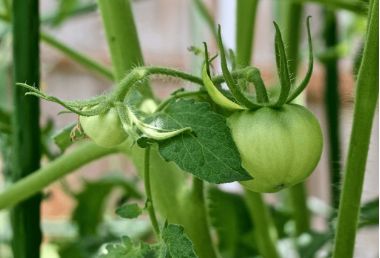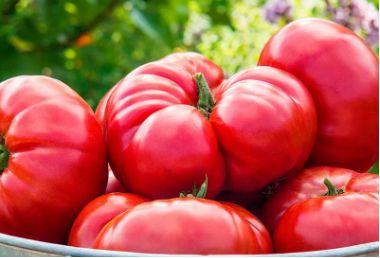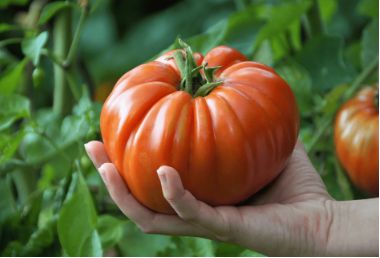The huge, beefsteak-shaped heirloom Mortgage Lifter tomato is a favourite among tomato varietals. Its usual 1- to 2-pound fruits have smooth, pinkish-red skins, few seeds, and a great, low-acid flavour. Under ideal circumstances, the fruit may even weigh up to four pounds. This tasty heritage tomato, known to tomato breeders as Radiator Charlie’s Mortgage Lifter, has been a favourite among farmers and tomato enthusiasts since the 1930s. Cats, dogs, and horses are all poisoned by tomato plants.
| Mortgage Lifter Tomato | |
|---|---|
| Common Name | Mortgage Lifter, Radiator Charlie’s Mortgage Lifter |
| Botanical Name | Solanum lycopersicum ‘Mortgage Lifter’ |
| Family | Solanaceae |
| Plant Type | Annual fruiting vine |
| Size | Vines to 9 ft., fruits to 2 1/2 lbs. |
| Sun Exposure | Full |
| Soil Type | Well-draining loam |
| Soil pH | 6.2 to 6.8 |
| Bloom Time | Summer |
| Hardiness Zones | 2-13 (USDA) |
| Native Area | Peru, Ecuador, Bolivia |
| Toxicity | Toxic to cats, dogs and horses |
How to Plant a Tomato Mortgage Lifter

When tomato seeds are sown indoors six to eight weeks prior to the final anticipated frost date, the plants have a better start and produce fruit early. Before planting in the garden, harden off seedlings when multiple sets of leaves are present.
How Soon to Plant a Mortgage? When the soil is warm—roughly 65 to 70 degrees Fahrenheit—and the nightly low is above 50 degrees, lifter tomatoes should be planted outside. As long as the weather is warm and sunny, tomatoes can be planted in the southernmost planting zones in the autumn or late winter. When there is no longer any chance of a frost, put them outside in more temperate zones between mid-April and early June.
Digging a shallow hole, laying the tomato plant on its side, and covering it with soil so that just the top two sets of leaves are visible is an additional technique. This method helps develop a sturdy plant by encouraging additional roots to form down the stem, which is especially beneficial for lanky plants.
Care of Mortgage Lifter Plants
Managing the enormous, abundant fruits and extraordinarily tall vines is the main problem while growing Mortgage Lifter. With above-average resistance to disease and drought, this heritage tomato is relatively little maintenance. Mortgage Lifter’s breeder, M.C. Byles (also known as Radiator Charlie), spent six years cross-breeding his favourite tomato plants to create a large, delicious fruit that was resistant to disease.
Brightness
It is best to get eight hours of sunlight each day. In particular, ripening fruit and healthy plants require plenty of sun.
Soil
Rich loamy soil with a pH of 6.2 to 6.8 is ideal for tomato plant growth. Soil that drains well is necessary. Steer clear of growing tomatoes where nightshade plants have been cultivated since the soil may still have pests and illnesses that harm tomatoes. To cultivate the healthiest garden, rotate your crops.
Water
Every week, established tomato plants require one inch of water. When irrigated on leaves, pathogens in the soil that cause fungal and leaf spot diseases are best prevented by drip irrigation.
Humidity and Temperature
The ideal range of temperatures for fruit development and set is 65 to 85 degrees Fahrenheit. Plants may not blossom above or below this range, and flowers may drop without bearing fruit. Uneven ripening and flavour might arise at temperatures higher than 95°F. For tomatoes to grow, 65 to 75 percent humidity is enough.
Apply fertiliser
Particularly big, indeterminate beefsteak types like Mortgage Lifter, tomatoes can be heavy eaters. The nutrients your tomato crop requires can be supplied by adding aged compost to the planting area in the autumn or early spring. Alternatively, you can plant after using a balanced fertiliser with an NPK of 10-10-10.
An earlier soil test can identify potential deficiencies and identify whether any amendments are required.
Pollination Marginal Lifters have both male and female components because they are self-fertile flowers. To enable self-pollination, pollen descends within the bloom. Although pollinating insects and the wind help, they are not required for the plant to bear fruit, even though you may observe them drawn to blooms. A single plant can yield 12 to 20 pounds of tomatoes.
Mortgage Lifter Types
The moniker Mortgage Lifter also refers to a second yellow variation in addition to the traditional reddish-pink form. The yellow Mortgage Lifter is a different variety of beefsteak that bears 1- to 2-pound fruits that are somewhat flattened and have reddish-pink stripes in the middle. The yellow kind produces sweet, mild tomatoes.
Gathering Mortgage Lifter
After transplanting, Mortgage Lifter tomatoes can be harvested about 80 days later, while some tomatoes might be ready as early as one week. In contrast to other heritage cultivars that maintain green or dark-colored hips at the tip of the stem, Mortgage Lifter often acquires a consistent reddish-pink hue all across.
Cut the tomato from the vine, leaving approximately an inch of stem connected to the fruit, using a hand pruner or snipper.
You can pick the fruit as soon as it starts to turn colour if you have problems with insects nibbling on your tomatoes. To allow the tomato to fully ripen, place it on a windowsill.
Growing Mortgage Lifter in Pots: A Guide
Owing to the vines’ length—9 feet and beyond—growing Mortgage Lifters in pots is not advised.
If you want to give it a shot, fill a 10-gallon container or less with a high-quality soil and compost mixture.Pick one that has enough space for a strong support and lots of drainage holes.During the first few weeks of growth, plant in a deep hole and remove suckers as needed.Patio growers may be able to successfully produce several of these enormous, delicious heirlooms, though the yield will probably be lower.Tomato plants in pots often require twice-daily watering due to the soil’s tendency to dry up quickly.Feel with your finger to check the top inch of dirt. Ignore the need to water if it’s moist. Add water if it’s dry.
Trimming
Vining tomatoes are indeterminate and grow quickly. Early in their growth, heirloom tomato varieties such as Mortgage Lifter will yield a bumper crop of suckers. Plant health is improved when it is pruned down to a few manageable vines because good air circulation helps avoid disease. During the first few weeks of growth, remove suckers to maintain optimum air circulation.
When the season is almost over, you can also reduce the amount of vines. Trim the tip end of the stem back to the developing fruit with pruners. This focuses energy on ripening rather than budding new fruit and flowers.
Mortgage Lifter Tomato Propagation
It is possible to grow tomato plants from suckers. To accomplish this, let a sucker develop to a length of approximately 6 inches, then clip it from the base of the mother plant, root it in water, and plant it in a different spot. Starting with seed is a more effective way to propagate Mortgage Lifter since it takes 80 days for it to mature.
Mortgage Lifter Tomato Growing Instructions:

The seeds from your Mortgage Lifter crop can be saved for planting the following year. Don’t discard the excess seeds that are still in the packet from the previous year because they are consistently durable.
In a heated indoor environment, seeds can be planted six to eight weeks prior to the final frost. Once the seeds grow, you will require a decent source of light.
To begin, collect your seeds, a plastic dome or bag, soilless seed starting mix, and little 3- to 4-inch pots or cell flats.
- Use warm water to moisten the seed starting.The mixture ought to be damp but not drenched.
- Planting mix should be added to every cell or container.
- Press a little indentation into the centre of each with your index finger. Sow seeds 1/8-inch deep.
- Add some more soilless mix on top, then cover the tray or pots with plastic.
- Keep your beginnings wet and place them in a warm place (preferably between 70 and 80 degrees Fahrenheit).The use of a heat mat expedites germination.
- Once the seeds have sprouted, which should take approximately a week, take off the plastic and move the plants to a window with plenty of sunlight or grow lights.
- Pot up seedlings into separate pots if needed, once they have grown two genuine leaves and are stable enough to handle.
- A week or so before transplanting in the garden, begin the hardening off process.
Typical Pests and Plant Illnesses
Mortgage Lifter resists wilting well. It is susceptible to several different bacterial and fungal issues that impact tomatoes. Crop loss can be avoided by starting with healthy seedlings and favourable growing circumstances. Disease prevention is aided by sufficient air circulation and plant spacing.
Aphids, army worms, and hornworms are the pests that typically damage tomatoes.
How to Get Mortgage LIfter to Bloom
When provided suitable growing conditions, this variety reliably and early blossoms. Try a fish emulsion foliar spray if flowers don’t seem enough. Apply compost tea or a fertiliser with a slightly greater phosphorus content, like a 5-10-5.
FAQ
Is the tomato Mortgage Lifter a good one?
One of the heirloom tomato varieties that produces the most fruit and is easiest to grow is Mortgage Lifter. The huge, beefsteak-shaped tomatoes taste sweet and low-acid, with few seeds. It tastes great in salads, salsa, and sauces as well as on sandwiches.
What is the maximum size of a Mortgage Lifter tomato plant?
Mortgage Lifter vines can reach a height of nine feet, so make sure you have supports available. 1 1/2 to 2 pounds is the typical fruit weight.
Is it difficult to raise Mortgage Lifter tomatoes?
One of the heirloom tomato varieties that is easiest to raise is Mortgage Lifter. If you are looking to produce a more traditional type, this is a fantastic plant to start with.Mortgage Lifter exhibits some resilience to drought and is resistant to tomato wilts.
When are my Mortgage Lifter tomatoes ripe enough to pick?
Approximately 73 days after planting, on a Mortgage Lifter plan, begin searching for ripe fruits. Their skin is a consistent pinkish-red colour and gives slightly when touched.






Leave a Reply